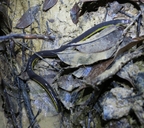|
Ichthyophis multicolor Wilkinson, Presswell, Sherratt, Papadopoulou & Gower, 2014
Colorful Ichthyophis, Colorful Ich | family: Ichthyophiidae genus: Ichthyophis |
| Species Description: Wilkinson M, Presswell B, Sherratt E, Papadopoulou A, Gower DJ 2014 A new species of striped Ichthyophis Fitzinger, 1826 (Amphibia: Gymnophiona: Ichthyophiidae) from Myanmar. Zootaxa 3785: 45-58. | |
 © 2018 Peter Brakels (1 of 5) |
|
|
|
Description Ichthyophis multicolor is the only Ichthyophis species besides I. tricolor that has a pale vent, as well as an adjacent darker stripe running lengthwise down the vent’s sides. It is differentiated from I. tricolor by its many more annuli (>325) and having tentacles farther from the nose than from the eyes (Wilkinson et al. 2014). In preservative, Ichthyophis multicolor has a whitish stripe that runs down the sides of its body, as well as a neighboring, darker, smaller stripe that runs down the sides of its vent. The backside of preserved specimens is brown grey in color, though the head is greyer. The vent is distinctly whitish, which contrasts with the darker underside. Underside color varies substantially, though it is lighter than the backside (Wilkinson et al. 2014). Larger caecilians generally have more teeth, though not substantially more than smaller ones. Smaller caecilians do not have as many scale pockets distributed on their annular grooves as larger caecilians. Some caecilians’ midventral regions are spotty white, others’ are with an irregular stripe, and some do not have white at all in that region (Wilkinson et al. 2014). Distribution and Habitat Country distribution from AmphibiaWeb's database: Myanmar
Life History, Abundance, Activity, and Special Behaviors Trends and Threats Relation to Humans Comments Ichthyophis multicolor descended from earlier Ichthyophis species who diverged from South Asia into Southeast Asia via northeast India. It is sister to all other Southeast Asian taxa of Ichthyophis (Wilkinson et al. 2014). It obtained its name for being more colorful than most other Ichthyophis (Wilkinson et al. 2014).
References
Wilkinson, M., Presswell, B., Sherratt, E.,Papadopoulou, A., Gower, D. (2014). ''A new species of striped Ichthyophis Fitzinger, 1826 (Amphibia: Gymnophiona: Ichthyophiidae) from Myanmar.'' Zootaxa, Originally submitted by: Gordon Lau (first posted 2014-10-20) Edited by: Ann T. Chang (2021-10-03) Species Account Citation: AmphibiaWeb 2021 Ichthyophis multicolor: Colorful Ichthyophis <https://amphibiaweb.org/species/8152> University of California, Berkeley, CA, USA. Accessed Nov 21, 2024.
Feedback or comments about this page.
Citation: AmphibiaWeb. 2024. <https://amphibiaweb.org> University of California, Berkeley, CA, USA. Accessed 21 Nov 2024. AmphibiaWeb's policy on data use. |


 Map of Life
Map of Life